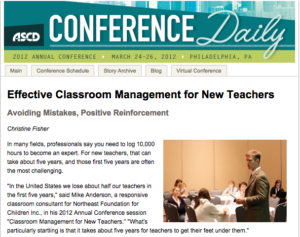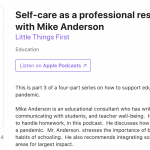ASCD Annual Conference Session: Classroom Management for New Teachers
Original Article: http://www.ascd.org/conferences/conference-daily/ac12/classroom-management.aspx
 Effective Classroom Management for New Teachers
Effective Classroom Management for New Teachers
Avoiding Mistakes, Positive Reinforcement
In many fields, professionals say you need to log 10,000 hours to become an expert. For new teachers, that can take about five years, and those first five years are often the most challenging.
“In the United States we lose about half our teachers in the first five years,” said Mike Anderson, a responsive classroom consultant for Northeast Foundation for Children Inc., in his 2012 Annual Conference session “Classroom Management for New Teachers.” “What’s particularly startling is that it takes about five years for teachers to get their feet under them.”
Classroom management is one of the most common reasons teachers leave the profession, and it is an area Anderson, author of The Well-Balanced Teacher, specializes in. During his session, Anderson shared his strategies for effective classroom management for new teachers.
Anderson said new teachers often make classroom management mistakes when they
- Forget to teach essential classroom routines because they are overwhelmed by the academic content they must cover.
- Struggle with competing views of what classroom management looks like: the fun, friendly teacher versus the firm, authoritative teacher.
- Make basic communication mistakes.
Entering the classroom, hanging coats, sitting in assigned seats, and eating breakfast are a few important daily routines that are essential for classroom management, but many new teachers forget to teach these.
To do so, Anderson stressed an interactive modeling approach in which teachers explain and demonstrate the desired routine or behavior, talk about it with students, ask a student volunteer to demonstrate, talk about the demonstration, and finally have all students try the routine. This system of repetition is vital, Anderson said.
Morning routines in the classroom set the tone for the rest of the day, said conference Katie Koons, a 5th grade teacher in North Carolina, during a discussion breakout. She said that she often asks a student volunteer to demonstrate what not to do, which engages more of her students.
To keep order in the classroom, Anderson recommended nipping bad behaviors in the bud through positive language reinforcement. He recommended that teachers try the following:
- Name concrete, specific behaviors rather than just using generalized “good job” phrases.
- Recognize all students’ behavior.
- Avoid personal approval statements, such as “I like….”
- Avoid manipulative language, such as praise for one student that indirectly punishes others for not acting in the same way.
- Use keywords such as kindness to stress classroom values.
- Be brief and set firm limits.
Stephanie Van Adelsberg, who teaches in Korea, plans to implement these recommendations right away, especially the tips to avoid personal approval phrases.
“I thought that was good classroom management,” Van Adelsberg said, “but when he explained it a different way, that really made me rethink [my strategies].”
To help new teachers incorporate effective classroom management strategies, Anderson suggested that they watch video of themselves, observe experienced colleagues, focus on one goal at a time, use visual reminders, and collaborate with other teachers to plan their lessons.




